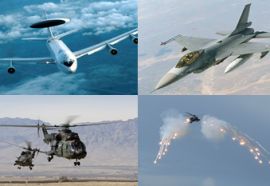 How can aircrews best protect themselves against land-based threat systems such as rocket-propelled grenades? NLR approaches this subject on various fronts.
How can aircrews best protect themselves against land-based threat systems such as rocket-propelled grenades? NLR approaches this subject on various fronts.
Since 2009, NLR has been involved in the European Defence Agency’s (EDA) research into protective measures against land-based threat systems, such as MANPADS (MAN-Portable Air Defence Systems), rocket-propelled grenades, machine-gun fire and lasers. Following the successful completion of two previous EDA projects, NLR has received three new follow-up projects, two of which were recently concluded.
NLR has developed a general toolkit with training solutions that aircrews can use to better protect themselves against land-based threats. For this purpose, NLR first determined what the current training activities within Europe are for fighter and transport aircraft and helicopters. The best-practices were then combined with the NLR’s training expertise in order to arrive at a practical set of training solutions. In addition to the analysis of training modules NLR developed a number of guidelines with which countries that do not have training programs can easily set up training modules or improve their existing training.
Another NLR study concerned the spread of in-theatre threat information. How is information about the locations of threat systems shared within one’s own network and with allies in a timely manner? The primary aim of this study was the dissemination of this threat information (location and nature). The study revealed that the most important prerequisite for this is interoperability. First, it must be technically possible to exchange threat information, for example via radio or with the help of digital data links. Second, it must also be organizationally possible; that is, units from the various countries must be aware of each other’s locations and must be willing and able to communicate, without bureaucracy or safety regulations standing in the way. Only when this interoperability is established can the manner in which threat information is disseminated be improved.
In addition, NLR, in collaboration with TNO, is engaged in mapping the developments occurring within European governments and industries in the area of aircraft protection against land-based threat systems. It is essential that the EDA acquire insights into current and future developments and national needs. With the resulting roadmap, the EDA can initiate future projects in the area of protective technology, including the necessary preliminary research initiatives. This roadmap helps the EDA promote European cooperation and identify areas in which future investments would be effective.
These NLR initiatives undertaken for the EDA result in more knowledge within the NLR, which, in turn, is used for providing services to the Dutch Armed Forces, for which collaboration is essential. All partners must be up to date about each other’s (training) backgrounds and manner of operations. Real-time information must be shared among the partners and the technical developments within industry must be adapted to meet the needs of the users.

